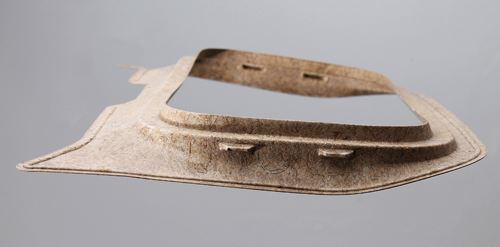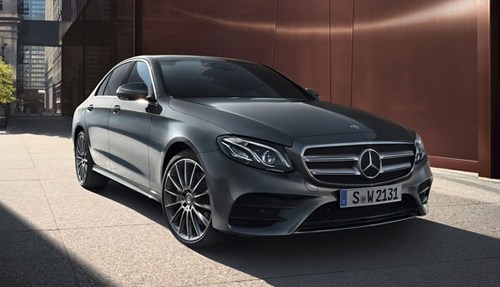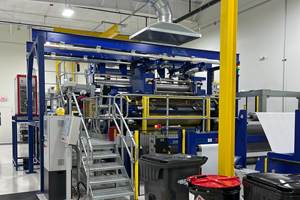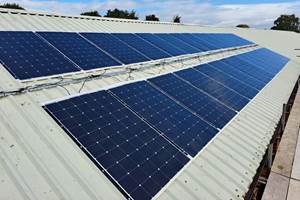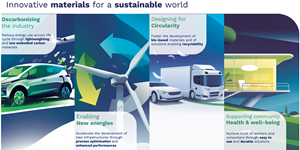IAC debuts FiberFrame on 2017 Mercedes-Benz
Germany-based International Automotive Components (IAC) has launched its ultra lightweight FiberFrame natural fiber sun roof frame on the 2017 Mercedes-Benz E-Class.
Automotive interiors supplier International Automotive Components (IAC; Düsseldorf, Germany) has launched its FiberFrame natural fiber sun roof frame on the 2017 Mercedes-Benz E-Class. The proprietary innovation is made of 70% renewable raw material content and provides up to 50% in weight saving compared to conventional metal-reinforced steel sun roof frames. The new Mercedes-Benz E-Class marks the mass-production debut of IAC's interior solution.
IAC's FiberFrame replaces the sun roof's metal reinforcement frame with a lighter frame employing strong, natural fibers using a new raw material comprised of 70% renewable content. This unique lightweight solution is reinforced using IAC's EcoMatHot natural fiber-based semi-finished material, which was especially developed for this application. The fiber mat is molded with a thermoset binder provided by BASF (see below) and is manufactured in-house by IAC in a hot molding process.
The new product has high stiffness for improved structural rigidity and enables up to 50% in weight saving compared with conventional steel frames. Compared to conventional thermoplastic frames, FiberFrame also prevents warpage after climate testing. In addition, mold tooling concepts for IAC's FiberFrame have much shorter lead times than conventional steel molding tools.
"Sun and panoramic roofs are increasingly popular across all vehicle sizes and segments," says IAC director of advanced engineering Fritz Schweindl, located at the company's Ebersberg, Bavaria, technology center. "This market trend inspired IAC to develop stiff and lightweight concepts, which help realize different fixation concepts on the car body, the sun roof or the panoramic roof module. Within its strategy of viable innovation, IAC leveraged its integrated material and process know-how to provide our OEM customers with significant weight savings, a lower carbon footprint for their vehicles and a more efficient production process."
"In the specification of the IAC EcoMatHot fiber mat, as well as in terms of tooling technology and production process of this innovation, we were able to take advantage of more than 20 years of experience working with natural-fiber-reinforced materials in automotive interiors," says Schweindl. "By manufacturing this product in-house in our headliner plant, we follow our strategy and expansion of vertical integration of our interior systems. Thanks to our global manufacturing footprint and standardized processes, we are now able to adapt IAC FiberFrame to customer needs and supply it around the world."
FiberFrame started production in November 2015 at IAC's Center of Excellence for overhead products in Prestice, Czech Republic, to support the Mercedes-Benz E-Class launch. The company also produces the headliner, the outer-rear wheel house liner, inner wheel house cover and rear seat cover for the vehicle.
FiberFrame binder
The Acrodur 950 L binder used in the FiberFrame system, provided by BASF (Ludwigshafen, Germany), is said to provide the necessary loading capacity and heat resistance of the lightweight component. As an alternative to phenolic resins, the water-based and low-emission binder strengthens the natural fibers and thus enables an environmentally compatible, dimensionally stable and lightweight solution for car roof frames.
“Natural-fiber roof frames based on Acrodur 950 L are around 40% lighter than roof frames made from metal. Hence, we help car makers achieve their sustainability targets because lighter vehicles consume less fuel and have lower carbon emissions,” explains Thorsten Habeck, head of marketing for Dispersions for Fiber Bonding at BASF.
“It was easy to integrate the BASF binder into our production system. The natural fiber components that are strengthened with Acrodur are ideal to mold; they are environmentally friendly and save time during the production of the composites,” says IAC's Schweindl. “Furthermore, the product is low in emissions, which means that it is safer to work with.”
Related Content
Park Aerospace launches aerospace, MRO structural film adhesive
Aeroadhere FAE-350-1 is a curing epoxy formulation designed for composite, metal, honeycomb and hybrid applications.
Read MoreBiDebA project supports bio-based adhesives development for composites
Five European project partners are to engineer novel bio-based adhesives, derived from renewable resources, to facilitate composites debonding, circularity in transportation markets.
Read MoreScott Bader, Oxeco partner for high-performance bonding solution
Joint technology breaks barriers to bonding lightweight flexible solar panels to roofing structures made from aluminum, coated steel and composites.
Read MoreResins, additives, adhesives and 3D printing solutions
CAMX 2023: Arkema’s broad portfolio of products for composites fabricators aim to enhance performance, durability and sustainability.
Read MoreRead Next
All-recycled, needle-punched nonwoven CFRP slashes carbon footprint of Formula 2 seat
Dallara and Tenowo collaborate to produce a race-ready Formula 2 seat using recycled carbon fiber, reducing CO2 emissions by 97.5% compared to virgin materials.
Read MorePlant tour: Daher Shap’in TechCenter and composites production plant, Saint-Aignan-de-Grandlieu, France
Co-located R&D and production advance OOA thermosets, thermoplastics, welding, recycling and digital technologies for faster processing and certification of lighter, more sustainable composites.
Read More“Structured air” TPS safeguards composite structures
Powered by an 85% air/15% pure polyimide aerogel, Blueshift’s novel material system protects structures during transient thermal events from -200°C to beyond 2400°C for rockets, battery boxes and more.
Read More

